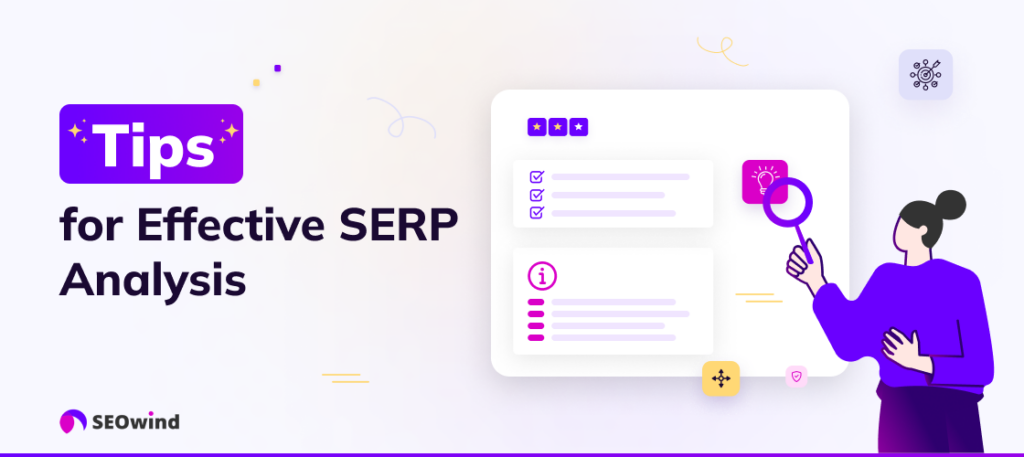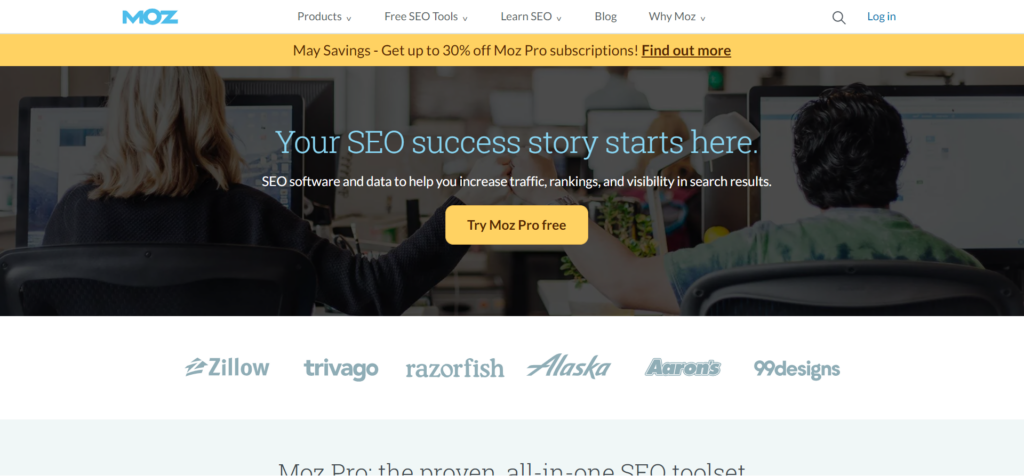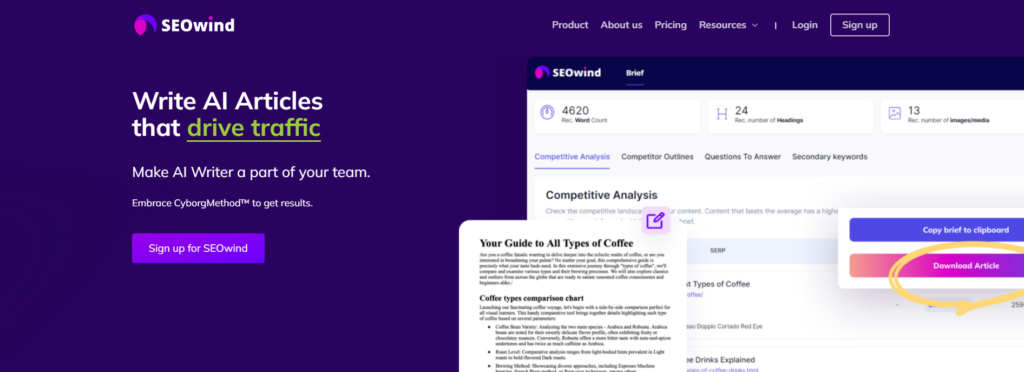Imagine you’re a treasure hunter, but instead of a jungle or set of ruins, you have the vast expanse of the internet to navigate. But you have a tool that leads you to the gold and provides insights into how other hunters are faring. This invaluable compass is a SERP analyzer.
Introduction to SERP Analyzers
Navigating the twists and turns of search engine optimization (SEO) can be like setting sail through uncharted waters. Considering the relentless competition we face today, having an edge can make all the difference. One such advantage comes from understanding not just your own strategies but also what others are doing. And this is where a SERP analyzer becomes indispensable.
What are SERP Analyzers, and why are they important for SEO?

At its core, a SERP analyzer reviews Search Engine Results Pages (SERPs) to allow you to peer beneath the surface of basic rankings. By deploying this tool, you can see which websites are outranking yours and why.
This level of insight offers more than vanity metrics. It shines a spotlight on actionable data that can boost your SEO tactics. Understanding nuances such as keyword emphasis and snippets showcased by top-ranking pages allows for tailored content strategies. Doing so refines your website’s relevance and authority in ways competitors might miss.
How do SERP analyzers help review search engine results pages?
The magic lies in the tool’s capacity to process extensive datasets swiftly, offering detailed insights that would take enormous human effort otherwise. From keyword density to backlink profiles or URL structure to page performance, each factor influencing SERP is scrutinized systematically.
With these tools, conducting free SERP analysis becomes an efficient task that guides users on positioning web pages for optimal visibility.
Features of SERP Analyzer

With an array of robust features, these SERP checker tools serve as indispensable instruments for any SEO professional or ambitious digital marketer.
Detailed analysis of organic search results
Think of a typical searcher scrolling through Google’s pages. What makes them click on one result over another? Understanding this behavior is crucial and is where detailed SERP analysis shines. By dissecting page after page of organic search results, SERP metrics reveal valuable information such as:
- Keyword frequency and distribution within top-ranking content.
- The prevalence of meta tags that resonate with end-users.
- The structuring styles of URLs that climb to pole position.
This granular deconstruction helps you replicate what works best in your niche and tailor your content accordingly.
Access to local search data for various locations
Say you run a bakery in Boston. It wouldn’t do much good to rank favorably for pastry lovers across the pond in London. That’s why local search data is worth its weight in gold for businesses targeting specific geographies. SERP position tracker capabilities allow us to peek under the hood at:
- How certain keywords perform across different locales.
- Which types of businesses dominate local pack listings.
- Insights into behavior trends among local and global audiences.
By analyzing divergent geographic datasets, you’re more equipped than ever to bake (or rank) locally while thinking globally.
Ranking difficulty evaluation for targeted keywords
Imagine trying to find a perfect spot on an overcrowded beach. It’s tough! A similar challenge exists when trying to rank for highly competitive keywords. SERP analyzers assess ranking difficulty by measuring:
- The domain authority and backlink profiles of competing sites.
- Content quality scores among existing top performers.
- Search intent alignment between query and prevailing results.
Arming yourself with this knowledge empowers you to strategically choose battles where victory is attainable versus facing steep uphill climbs elsewhere.
SERP position history tracking for competitor analysis
Keeping tabs on rivals’ past maneuvers can predict their future actions. By monitoring competitors’ SERP position history, we glean insights into:
- Their periods of ranking volatility, which can indicate successful or failed SEO strategies.
- How seasonal trends affect their performance throughout the year.
- Historical benchmarks that allow us to set realistic targets for our campaigns.
Tracking these historical breadcrumbs leads us closer to emulating and surpassing our competitors.
Integration with other SEO tools for comprehensive analysis
One tool alone might not hold all the answers. This is why integrating multiple platforms conjures deeper insights. Think about combining SERP checker tools with analytics dashboards or CRM systems. Such a fusion facilitates:
- A broader interpretation that combines user experience data from analytics with ranking data from SERP checkers.
- Enhanced keyword intelligence using both keyword planning tools alongside real-time rank tracking functionalities.
- Streamlined workflows where team members switch seamlessly from one facet of analysis to another, all under one integrated ecosystem.
Like gears interlocking within an intricate timepiece, integrated tools synchronize harmoniously to drive efficiency in your SEO endeavors and ensure no stone remains unturned.
Using SERP Analyzers for Keyword Research
Embarking on keyword research can sometimes feel like navigating a dense forest. The path isn’t always clear, and getting lost amidst the thickets is easy. However, with the compass that is a quality SERP analyzer, you can cut through the complexity and discover opportunities to propel your SEO efforts forward.
How to conduct keyword research using the tool
Conducting keyword research with a keyword SERP tool involves several crucial steps. Let me walk you through effective keyword discovery:
- Define Your Goals: Before jumping in, clarify what you aim to achieve with your SEO strategy—are you looking for more traffic, higher engagement, or improved sales conversions?
- Input Seed Keywords: Enter seed keywords related to your niche or industry into the tool.
- Analyze SERP Data: Examine the search engine results page (SERP) data provided, paying close attention to key metrics like search volume and keyword difficulty.
- Expand Keyword List: Utilize features within the tool to generate longer lists of related keywords, synonyms, and long-tail phrases. Each could be a potential ace up your sleeve.
- Assess Relevance and Intent: Ascertain whether these keywords align with user intent and if they are genuinely pertinent to your content offerings or services.
Remember that throughout this process, staying organized will save you from countless headaches down the line. Categorize your findings systematically to sift through them later during content planning easily.
Finding low-competition keywords with high search volume
For many budding SEO adventurers, striking a delicate balance between attainability and impact when choosing keywords is a top priority. Here’s how to uncover low-competition keywords buoyed by sizable search volumes:
- Use filters within your free SERP tracker to sort by “Competition” (or a similar metric), then look at those marked as “Low” difficulty.
- Check search volume data points. Aim for words or phrases with respectable numbers. Too little traffic won’t move the needle on your SEO gauges.
- Consider seasonality and trends. Some low-competition terms might become highly valuable during specific times of the year or amidst emerging trends.
Pro Tip: Don’t overlook the long tails! These lengthy variations tend to have lower competition and often signal higher purchase intent from searchers.
Uncovering keyword opportunities based on SERP analysis
Peering deeply into SERP analysis can reveal riveting narratives about what users are seeking and which queries remain underserved. This is prime ground for establishing quick wins in rankings. To do so, you should:
- Analyze Top Pages: Review pages that rank well for your targeted terms. Identify patterns like recurring topics or formats that indicate successful strategies.
- Investigate Featured Snippets: Peek at query spaces where featured snippets appear.
- Explore Related Searches: Look for topics adjacent to mainline queries through related searches offered by some tools to find untapped veins with rich SEO prospects.
Always keep the context in mind. The ideal term must fit harmoniously within both user expectations and your brand narrative to optimally connect needs with solutions.
Analyzing Competitors with SERP Analyzers
As you navigate the complex ocean of search engine optimization, one tool that should be a staple in your toolbox is a quality SERP analyzer. In particular, let’s dive into how Ahrefs’ SERP features can be wielded to gain an edge over your competition.
Identifying competitor strengths and weaknesses in organic search results
Imagine stepping into a ring where every fighter’s strengths and weaknesses are known to you ahead of time. That’s the advantage an effective SERP analysis offers when understanding your competitors. Here’s what you can do:
- Examine their top-ranking pages: With Ahrefs’ SERP checkup, note which of your competitors’ pages rank highly for your desired keywords. Is it blog content, product pages, or educational resources? This insight lets you see where they meet users’ needs better than you.
- Analyze their on-page SEO efforts: How well have they optimized their titles and descriptions? Do they use enticing meta tags that increase click-through rates (CTR)? You may discover opportunities to create more compelling metadata.
- Assess content quality and structure: Higher rankings often correlate with high-quality content. Look at how thoroughly their content covers the topic compared to yours. Could their skyscraper approach be trumping your shorter posts?
Through such robust evaluations, pinpointing where competitors excel can help guide strategic improvements in your SEO campaign.
Evaluating competitor ranking positions and visibility
Scrutinizing the SERP ranking report through tools like Ahrefs affords a clear window into where each player stands in the market hierarchy for chosen keywords:
- Identify ranking trends: When looking at competitor rankings, observe static positions and patterns over time. Are certain competitors consistently climbing while others fluctuate?
- Cross-reference with keyword difficulty: Are those high rankings achieved in highly competitive terrains, or are they dominating niche segments? Understanding this balance gives crucial context to their success.
- Break down by keyword groups: Sometimes, clusters of related terms provide more insight into strategic focuses than individual keywords.
This evaluation puts rankings and broader visibility strategies under microscopic scrutiny, which is critical for sailing to clearer SEO horizons.
Monitoring competitor strategies through historical data
The ripples of past tactics can inform future maneuvers. Because of this, studying historical data is pivotal. Doing this requires you to:
- Track changes over time: By leveraging Ahrefs’ capability to pore over archival snapshots, witness how today’s front-runners emerged from yesterday’s scrum. What shifts occurred in heading tags or page structures?
- Spot link-building campaigns: Backlinks tremendously sway domain authority. Observing spikes in backlink acquisition might signal intensified link-building efforts worth emulating or expose gaps in those attempts ripe for exploitation on your part.
By effectively peering through this rearview mirror offered by comprehensive historical data analysis, one can better forecast coming changes and adapt nimbly to keep pace with or even overtake competitors on these digital racetracks.
Implementing analytical tactics requires precision and savvy interpretation, which is as much art as science. Keep close tabs on these metrics using Ahrefs’ rigorous integrations for monitoring SERPs and sculpt a strategy refined by insights into your rivals’ history in search landscapes.
Optimizing Local SEO with SERP Analyzer
When approaching Search Engine Optimization (SEO), harnessing every tool at your disposal is essential for climbing the daunting mountain of search rankings.
Leveraging Regional Search Data to Improve Local SEO Efforts
Your journey begins with comprehending the lay of the land and understanding how local search results differ from broader searches. Here, “SERP location” isn’t just a keyword; it’s the gateway to tailoring content that resonates with an audience pinned down to specific geographical areas. Follow these steps to improve your local SEO:
- Begin by Mapping Out Your Territory: Utilize an SERP Analyzer to gain insight into what locals are searching for and which queries trigger location-based results.
- Know Thy Neighbor: Scrutinize hyper-local keywords and phrases common in the area on which you’re focusing. These may vary significantly from one locale to another.
- Cultivate Content That Speaks Locally: Craft pages and posts integrating local lingo, landmarks, events, or issues that stir up community interest, guided by what your analyzer reveals.
By employing these tactics through your SERP Analyzer’s data on SERP location trends, you’re not just optimizing SEO but speaking directly to a community eager for relevance.
Analyzing Local Search Results for Targeted Locations
Next up on this venture is a thorough analysis of search results within targeted locales. What appear as mere listings on a page are actually nuggets of gold waiting to be panned. To succeed, you will need to:
- Zoom in on Nuances: Each city has its subtleties. A phrase popular in one might be non-existent in another. Catch these nuances early by examining variations across different locations.
- Study Successful Contenders: Look at who already ranks well locally and understand why they appeal to hometown crowds. This could be due to their localized keyword usage or community engagement strategies.
- Keep an Eye on Seasonal Trends: Different regions have seasonal quirks affecting searches, like tourism highs or festival periods, when specific terms might spike.
Analyzing SERP locations allows you to uncover patterns that work best within each targeted region.
Finding Opportunities to Outrank Competitors in Local Searches
The final step in our exploration requires a strategy to pinpoint chinks in competitors’ armor that you can exploit. This is how you can approach it:
- Seek out Gaps: Find service areas or products that are not adequately covered by competitors but are still sought after by locals.
- Smart Positioning: Is there room at local events or forums where you could shine brighter than rivals? Use your SERP Analyzer’s insights for strategic positioning.
- Link Up Locally: Cultivate relationships with nearby businesses for mutual backlink opportunities, enhancing each other’s standing in local searches.
Outranking the competition isn’t about going toe-to-toe on every front. Instead, utilize untapped SERP location niches they’ve overlooked or can’t fully commit to.
Advanced Metrics and Insights with SERP Analyzers

Exploring advanced SEO metrics available in the tool
A SERP Analyzer is akin to a compass in the hands of a navigator. Here’s why I get excited talking about it: this tool isn’t just about rankings. It uncovers a wealth of advanced SERP metrics that can transform your strategy, such as:
- User Experience Signals: This includes click-through rate (CTR), dwell time, and bounce rate, which indicate how users interact with your site.
- Backlink Profile Analysis: Understand the strength and quality of your backlink profile, an essential facet of domain authority.
- Content Relevance Score: See how well your content aligns with user intent, a critical factor in satisfying users and algorithms.
- Mobile Readiness: With mobile traffic dominating, this metric assesses how friendly your site is to mobile users.
Tapping into these rich veins of data enables you to make informed decisions that push you ahead in the SEO race.
Gaining insights into SERP features and their impact on CTR
SERP features are like bright billboards along the highway: they catch the eye and significantly influence traveler behavior. And online, these translate into elements such as featured snippets, local packs, or knowledge graphs. Examining these through a nifty SERP Analyzer reveals their profound effect on CTRs because they often provide information on the results page, encouraging clicks by inciting curiosity or satisfying queries then and there:
- A site listed in a local pack might notice higher CTR due to prominent displays and geographic relevance.
- Having a page summarized as a featured snippet could either increase clicks if readers want more than a teaser or reduce them if their query has been answered outright.
Understanding these nuances is crucial, and leveraging them effectively enhances visibility exponentially.
Monitoring rich snippets and structured data for enhanced visibility
Rich snippets’ additional bits of descriptive text, ratings, or images can set your listing apart from standard ones. They’re powered by structured data embedded in your website’s code.
Monitoring these elements using SERP Analyzers allows us to pull back the curtain on opportunities for enhanced visibility by:
- Identifying pages where adding schema markup could lead to rich snippets.
- Analyzing competitor pages that already utilize rich snippets successfully.
- Investigating potential reasons for markup not being displayed despite proper implementation.
This monitoring equips you with actionable insights to guide adjustments tactically.
Tips and Best Practices for Effective SERP Analysis

Embarking on a SERP analysis journey can be akin to mining for gold in the vast landscape of search engine data. With the right strategies and tools, you can uncover insights that propel your website to new heights.
How to Interpret and Utilize the Data Provided by SERP Analyzer Effectively
Think of a SERP analyzer as a high-powered telescope looking into the universe of Google’s search pages. To interpret this cosmos of information effectively, consider these steps:
- Understand the Metrics: Know what each metric stands for, whether it’s click-through rates (CTR), organic positions, or featured snippets. Recognizing how they affect your site gives you a clearer picture.
- Use Historical Data: Look at past data trends, which often predict future patterns and show where you might capitalize.
- Assess User Intent: Try stepping into your audience’s shoes. What are they seeking? Analyzing user intent behind queries helps tailor your content effectively.
- Spot SERP Features: Identify if special features like local packs or knowledge panels dominate the results page. These clues tell you what kind of content Google favors for particular queries.
Interpreting data provided by a SERP analyzer is not just about numbers. You’ll also need to craft stories that resonate with readers and algorithms. Make sure to translate these insights into actionable tasks, such as optimizing on-page elements or creating richer content strategies.
Best Practices for Conducting Thorough Competitor Analysis Using the Tool
When diving into competitor analysis, employing methodical approaches ensures comprehensive insights:
1. Identify Key Rivals:
- Start by pinpointing who truly competes in your digital space; a simple “who ranks where” approach won’t cut it.
- Dive deep into domain comparisons to create a broader image of their SEO efforts.
2. Track Ranking Shifts:
- Keep an eye on fluctuations in competitor rankings over time. Stability can be just as telling as volatility.
3. Examine Backlink Profiles:
- Evaluate not just quantity but quality, too. The caliber of backlinks can support authority more than sheer numbers.
4. Study Content Quality and Relevance:
- Scrutinize your rivals’ top-performing pieces. What makes them tick? Are there gaps you could fill?
5. Monitor On-page Optimization:
- Assess title tags, headers, and meta descriptions. Minor tweaks can sometimes lead to significant leaps on the results page.
Effective competitor analysis involves shadowing adversaries and learning from them to turn observed tactics into innovative practices that surpass standard benchmarks.
How to do SERP analysis is a layered question. It requires technical understanding and creative ingenuity when interpreting data or evaluating competitors. Use these guidelines to navigate through vast oceans of information. By harnessing best practices robustly, one can convert analytics into actions that brighten the beacon of their online presence amidst competitive tides.
Increasing Search Engine Visibility with SERP Analyzer
When you embark on the voyage to amplify your website’s visibility, using a SERP Analyzer can be akin to navigating the high seas with an expertly crafted map. This map – your SERP analysis – is brimming with clues about the online terrain dominated by the competition. Peering through the lens of an SERP Analyzer illuminates your path, allowing you to make data-informed decisions that steer your SEO efforts in the right direction.
Applying the insights gained from SERP analysis to improve website visibility
Imagine standing at a vantage point where you can see how your competitors scale their ranks on search engines and replicate their most successful tactics. A robust SERP analysis places this panoramic perspective at your fingertips.
- Identify High-Performing Content: Dissect top-ranking pages not just for keywords but also for their content structure, length, visuals, and tone.
- Understand User Intent: Analyze which content formats captivate your audience.
- Monitoring Backlinks: Observing who links back to competitor sites can uncover opportunities for networking and link-building strategies.
These actions empower you to fine-tune meta descriptions, headings, and page titles that align more closely with what users and search engines are seeking.
Optimizing content strategies based on competitor analysis and keyword research
As you deepen your understanding of SERP competition, it’s time to mold those findings into a stellar content strategy. The interplay between analyzing competitors’ tactics and diving into keyword research sets the stage for SEO success:
- Craft Content That Counts: Write authoritative pieces that satisfy search queries better than existing resources.
- Optimize For The Right Keywords: Integrate long-tail keywords naturally into your content. These gems often have lower competition yet attract highly targeted traffic.
- Break New Ground: Uncover gaps in competitors’ content strategies and fill these with fresh takes or comprehensive guides on overlooked topics.
Optimizing your strategy involves adapting and innovating based on what the data suggests to capture attention and clicks within search engine results pages (SERPs).
The blend of analyzing SERP competition through a capable analyzer and skillfully adapting both onsite elements and off-page factors epitomizes tactical advancement in SEO. Following these steps isn’t just about keeping pace. It’s about setting new benchmarks for others in pursuit of digital excellence.
Selecting the Right SERP Analyzer Tool
With the digital landscape teeming with an array of SEO tools, picking the most effective one can be daunting. This holds especially true when you pursue a specialized instrument such as an SERP analyzer. The following subsections will guide you through pivotal factors and comparisons that should inform your selection process.
Factors to consider when choosing an SERP Analyzer tool
Imagine stepping into an orchard ripe with fruit; each variety promises its own flavor and nutritional value. Similarly, SERP analyzers each possess their unique features and benefits. Here’s what you’ll need to consider when finding the perfect pick from the orchard:
- Accuracy: Central to any Google SERP checker is accuracy. Ensure that the tool consistently offers precise data on search engine positions.
- Real-time Data: You want insights hot off the press, or in this case, freshly updated rankings directly from Google’s dynamic results pages.
- Mobile Compatibility: Much of today’s internet traffic hails from mobile devices. As a result, a mobile SERP checker keeps you not only informed but also relevant.
- Ease of Use: It goes without saying that user experience must be seamless. Complex functions are great, but not if they send you down a rabbit hole of perplexity.
- Keyword Diversity: Your archetypal online SERP checker should grant access to long-tail and short-tail keyword analysis for a well-rounded strategy.
- Competitor Analysis Features: Analyzing competitor’s grants perspective! Tools offering granular insight into competitors’ performance can be invaluable.
Before committing to a purchase decision, consider these points carefully!
Comparison of popular SERP Analyzer tools in the market
Wouldn’t it be splendid to taste-test every apple before deciding which bag to fill? In the world of SEO tools, we have resources providing comprehensive reviews and head-to-head matchups. Let me walk you through some well-known contenders:

- A powerhouse suite whose Site Explorer doubles as an advanced online SERP checker.
- Offers detailed organic search reports alongside lost and new keyword tracking.
- Some may find it more costly than others with similar offerings.

- Often praised for its vast database and depth in competitor research capabilities.
- Incorporates social media tracking along with traditional SERP metrics.
- It can feel overwhelming for beginners due to its robust feature set.

- Renowned for user-friendly interfaces coupled with powerful Local Market Analytics, making local SERP review easier.
- Provides exemplary customer support often lauded by users new to SEO instruments.

- SERP analyzer for content writing,
- In-depth analysis of top-performing pages in terms of keywords and content structure.
When considering how to check SERP ranking effectively using one of these tools, consider their specialized capabilities.
Final thoughts and next steps for utilizing SERP Analyzer effectively
Stepping into the arena of SEO can sometimes feel like embarking on a hike through uncharted wilderness. Every path you take is a mix of educated guesses and strategic choices. But with a top-notch SERP Analyzer, navigating this terrain becomes less daunting. Your journey towards SEO success is one in which each step is informed by insights gleaned from a comprehensive analysis of search engine results pages (SERPs).
Embarking on this trek requires more than just obtaining the right tool. You’ll also need to use that solution adeptly. Here are some actionable suggestions to ensure that your use of a SERP Analyzer isn’t merely a one-time affair but part of an ongoing strategy:
- Keep Analyzing Regularly: The digital landscape is ever-changing. What works today might not be as effective tomorrow. Make SERP analysis a regular fixture in your SEO routine.
- Be Agile with Your Strategies: As you uncover trends through the SERP Analyzer, adapt your strategies accordingly. This flexibility can make all the difference between being seen or sliding into obscurity.
- Involve Your Team: Share insights with content creators, marketers, and developers so everyone can work together to achieve better visibility and higher rankings.
Use what you’ve learned here to optimize existing content, inspire new material, and outmaneuver competitors at every twist and turn.
With patience and persistence, strategically deploying your SERP Analyzer will illuminate patterns in user behavior, content consumption preferences, and market gaps that are ripe for your unique input. Ultimately, view this technology not as a mere tactical device but as part of a holistic approach to mastering search engines.
By embracing these final thoughts and gearing up for continual learning and optimization using your chosen SERP Analyzer tool, you’re not just ticking boxes; you’re crafting an enduring story where each chapter spells greater success in connecting with your audience through search engines. Welcome to a tale of triumph in SEO!


